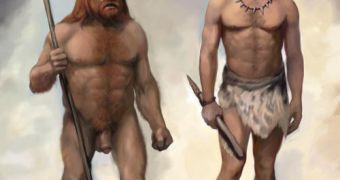The last Neanderthals may have gone extinct in their last stronghold in Gibraltar 24,000 years ago, but we still can hear their voice. At least, a computer made a variant of it, in an attempt of a team led by Robert McCarthy, an anthropologist at Florida Atlantic University in Boca Raton, as signaled by New Scientist. Unlike modern humans, the Neanderthals could not pronounce the quantal vowels, which enable a listener differentiate the word "leap" from "lip", for example.
"Quantal vowels provide cues that help speakers with different size vocal tracts understand one another. They would have spoken a bit differently. They wouldn't have been able to produce these quantal vowels that form the basis of spoken language," said McCarthy at the annual meeting of the American Association of Physical Anthropologists in Columbus, Ohio, on April 11.
Linguist Phil Lieberman, of Brown University in Providence, Rhode Island, calculated for the first time, in the '70s, the size of a Neanderthal larynx starting from its skull. The results suggested that Neanderthal speech lacked the subtlety of modern human speech. Those results were contested by many pointing to archaeological proofs of an oral Neanderthal culture and errors in Lieberman's measurements.
The team simulated Neanderthal speech based on new vocal tracts reconstructions made on three 50,000-year old French Neanderthal skulls. So far, the team has come with a Neanderthal "E", but the researchers plan to construct an entire Neanderthal phrase.
"Though subtle, the linguistic difference would have limited Neanderthal speech," said McCarthy.
"That conclusion doesn't fit in with Neanderthals' large brains, which may have been an adaptation to language. Ultimately what is important is not the anatomy of the mouth but the neuronal control of it. Neanderthals may have also boasted the genes for language," said Erik Trinkaus, an anthropologist at Washington University in St Louis, whose team has made analyses of Neanderthal DNA.
DNA analyses made in 2007 revealed that Neanderthals had the same FOXP2 gene variant like modern humans. The lack of this gene induces language and speech disorders in humans. The human FOXP2 gene is specific for our species, being different inclusively from that of the chimpanzees, our closest living relatives. But other studies point to a more recent evolution of the human speech, between 80,000 to 40,000 years ago.
"Some genes important to hearing changed rapidly in modern humans, perhaps because the genes helped decode new, more complex spoken languages. Something's changing in the last 40,000 years. Maybe this is because our ears are becoming tuned to listening to sounds that have recently been changing," said John Hawks, a biological anthropologist at the University of Wisconsin in Madison.

 14 DAY TRIAL //
14 DAY TRIAL //